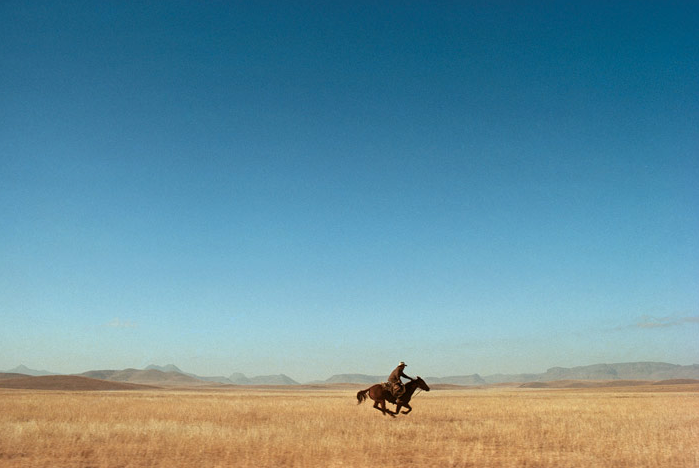Sunday, September 25, 2011
Conglomerate Post



10 Rules, Afraid, and Photographer

Ten Rules and hesitations.
- Lightroom & Bridge are the gods of editing and viewing photography.
- If possible, take more than one shot of the same thing. It's the worst when a shot looks in focus on your camera's lcd, but in reality is noticeably off.
- Horizon lines should never be dividing your photo in half.
- Kids move fast, ALWAYS be prepared and ready when they are your subject.
- Shooting outdoors on a clear day an hour or so before sunset will give you gorgeous light every time. Plan shoot times accordingly.
- Be friendly with people, especially when you're shooting. You never know what opportunities can arise from it, or knowledge you can gain.
- Go on an adventure. Take the long way home. Explore a place you've never been.
- Take your time.
- Carry a camera with you everywhere possible. 9/10 times that shot you missed won't be there when you come back.
- Don't force it.
Dani
Her work has a sort of faint sfumato thing going on, all of them with cool, muted tones, even the ones with reds in them appear calm and collective. The portraits are really odd, appearing to have a creepy or somber air about them, especially the backlit ones. Her portraits in black and white have similar feelings, but in more extreme ways: the sort-of-creepy ones are creepier, the not-as-creepy ones are calmer.
Her photographs of other miscellaneous items also appear to have cool tones and muted colors; they are also beautiful, but seem sort of common, I suppose.
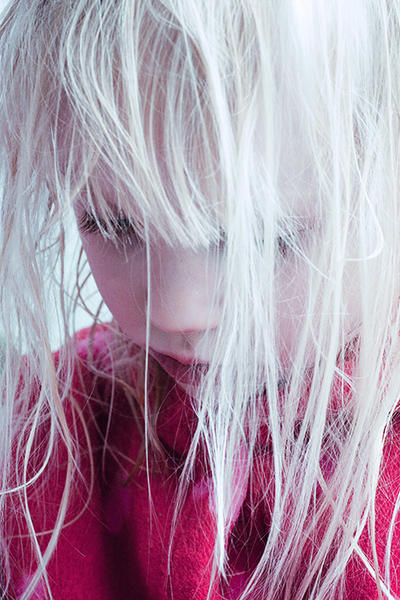

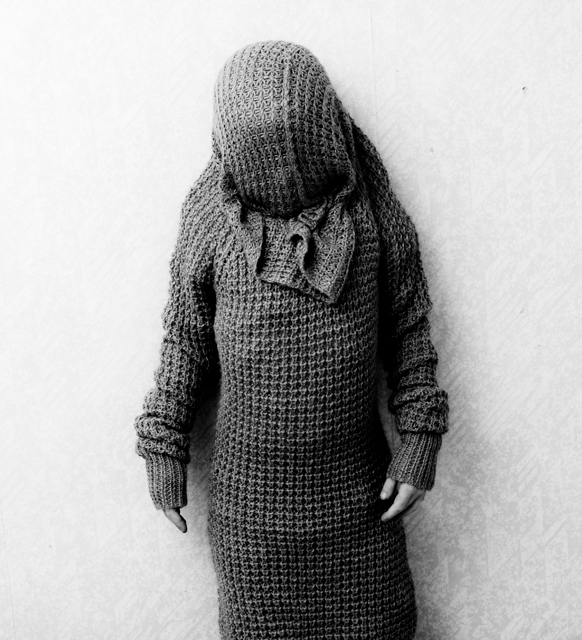
Artist, 10 rules, Photo
http://scherer-food-photography.com/
My ten rules to a good photograph:
1) Shoot at about .5-1 stop under what the camera's meter says is correct
2) The subject should (almost) never be in the center of the image, it should interact with the rest of the information in the frame
3) Don't be distracted by bright colors alone, the image will end up empty
4) Railroads, lane dividing lines in the middle of the road, or any kind of parallel lines that disappear into the distance should not be the subject of the image
5) Try and capture a connection or interaction between two or more things/people
6) Posed photos should be taken in a studio setting
7) Never use the camera's flash
8) Don't get too shutter happy
9) Try to be invisible as a photographer
10) Remember to look around with your eyes, not just through the lens
The photograph that I've been scared to take is one of great grief or despair. I have not yet had the courage to shoot a photograph of people crying or in pain. I feel rude and insensitive to the emotional situation. However these are the photographs that people remember, because they strike your emotions as a viewer.
Photo I'm afraid to take. artist. 10 rules
http://fotorobert.republika.pl/krajobrazy1.html
Robert Urbanksi is a Polish photographer who tends to capture typography. Although he does so well—visually pleasing—I find that style boring. I really appreciate the landscape photos he does. I personally, don’t like to take pictures of landscapes. For some reason I find too many other things more interesting, like close ups of objects and portraits. He captures landscapes beautifully which is something I’m not very good at. The exposure is perfect and the framing is interesting. Each photo makes me want to keep staring at it which is something I admire and hope to achieve in my work.
The photo I’m afraid to take.
I’m afraid to take a photo of landscapes with a film camera in black and white. First of all, like I mentioned earlier, I don’t really enjoy photographing landscapes. However, I find them appealing when other people capture them, and I’d like to try. I tend to find the appeal in the color of landscapes, not necessarily the shapes and shadows. I’d like to use a film camera to capture light well enough to make the picture stand out as color does.
My 10 rules:
1. Subject: there needs to be an interesting subject present in the photograph. I don’t like taking pictures of nothing.
2. The photo should contain a person more often than not. At least that’s how I roll.
3. Lighting: a perfect photo needs dramatic lighting.
4. Aperture: the aperture needs to be perfect. I don’t like having to edit the lighting of a photo. It should be perfect from the start
5. No flash: Flash is almost tacky. It reminds me of snapshots that people that don’t know what they’re doing take.
6. Shutter Speed: should be slowish. I feel like it captures more for some reason
7. Steady Hand: the photo needs to be clear. I hate blurry pictures.
8. Framing: I think following the rule of thirds is an excellent guide. It really helps making the photo more interesting.
9. Shallow Depth of Field: I find close ups to be more interesting than being able to see everything in the shot.
10. The photo lastly should be balanced. Everything in the frame should be acknowledged when shooting.
Ten Rules to Photography or: The Photograph I'm Scared to Take
- Tell some kind of story.
- Show something most people would not see.
- Make the composition as much about the negative space as it is the positive.
- Take more than one photo of your subject; it is likely that you won't use the first one, even if you think it's perfect when you take it.
- Take the photo you see in your mind at first, and then shoot the same thing in a different way.
- Do not be afraid of people looking at you.
- Shoot more photos than you need or want.
- Do not follow the "basic rules" of composition blindly; put your subject right in the center, cut part of it off, do whatever you need to do to show what you want to show.
- The final product of the editing of a photograph should look better than what your grandma can do with Instagram.
- Thou shalt not complain about what model camera you're using. A good photographer can capture a good image with a cell phone camera (although that's not recommended for practical reasons).
- There are no rules!!!!! Have fun!!!!!!!!! Give 110%!!!! There's no I in team!!!!!!!!!!!!!

My photographer this week actually incorporates my “fear” in photography. He is more of a portrait photographer than anything but it is obvious that is not all he is capable of. He does a lot of nude photography that is graphic but it is tastefully done. I see his subjects nudity last when looking at his work. His photographs are well exposed and he seems to challenge the rules of photography. His subjects’ all seem to have a serenity and mystery within their expression or pose. He plays with light and his work over all has this hazy, late late afternoon feel about them. His photos have an almost vintage feel to them. He seems to take a lot of his photographs at dusk while the sun is descending. He definitely inspires me to conquer my own apprehension in nude photography.
10 Rules to a good photograph
1. I think a good photograph comes from the environment and the state of the photographer. The photographer should minimize all distractions. If a photographer puts all of his/her attention into individual photographs it will be a successful experience.
2. Going into a photographing, I think that you should have a concept for the shoot. My most successful photographs have come out of a conceptual shoots rather than wandering around looking for a photo.
3. I think a good photograph is of something that no one really thinks about in a location. Find emotion in each location you shoot. Emotions are not just happy and sad but also think of words like uneasy or awkward . Be purposeful.
4. Expose your photos correctly. I do not mind a darker photo because it can convey more detail but an overblown photograph has no detail to it, can look like a snapshot and even when edited you can only get limited detail. Try your hardest to get it done in camera.
5. Beware of the snapshot. I think it is good to continuously shoot but don’t remember to have be conceptual. It is better to choose from a group of well-exposed and detailed photos rather than choose from the photos that you “got lucky” with.
6. ISO is SO important. If you can, shoot below 800 to get a good quality shot. Adjust shutter speed and aperture to help with lighting.
7. Clichés are boring, overdone and uninspiring. For example, Tree photography; if you are going to take a photo of a tree examine it from all angles.
8. Don’t be afraid to look stupid, you won’t regret it if you get a good photograph. Crouch low, bring a ladder, and get on your back. Experiment.
9. To be honest the rules of photography are just guidelines, I think breaking those rules is what photography is all about.
10. Never copy an artist but use other artist, photographers, and people as inspiration. Keep up on your peers and other photographers. You will explore so many other types of angles, exposures and ideas. Learning about new artists never hurt.
Photograph I have always wanted to take but was too afraid to take
I don’t think I am necessarily afraid to take any photographs. I think that something that could be intimidating and a new experience for me would be nude photography. I am not necessarily scared to shoot it but it would be a more intimate type of photography, which would put me in a different comfort zone. I have not had the opportunity to shoot nude models because frankly I have never asked anyone to pose for me. I think that the nudity in photography can be too cliché and used as shock value. I think that it is a intimidating subject matter because I don’t want to just photograph a naked person. If I were to photograph someone nude I would want it to be original and my own.

The Most Obnoxiously Long Blog Post Ever Written



My Ten Rules When Taking Photos:
- Don't over think the composition.
- No random trees/branches invading important negative space.
- Depth of field- think about what kind you want.
- Camera shake is unacceptable.
- Take multiple versions of every photo.
- Observe everything in the frame, and make sure it all works.
- Don't over-use macro. Sometimes it is successful, sometimes it is cheesy.
- Always try to use 200 ISO or smaller, when possible. (Too much of a perfectionist for noise)
- Have I seen this photo before? If so, forget it.
- Notice and pay close attention to the little things.
I feel like mine is a bit cliche, but oh well, I'm just trying to be honest. I have always wanted to find a homeless colony and take photos of it. My best friend's fencing club (Richmond Fencing Club) has an area in the woods behind it where tons of homeless people live, and I've always wanted to take photos. I am terrified, however, of agitating the people who live there or feeling too awkward to actually take the photos. Generally, I'm still pretty afraid to take photos of strangers, and the fact that I would be singled out in a homeless colony just exaggerates that fear. I've always had these ideas of photos of the homeless, in their own environment (how ironic is that?), but I have always been too scared to actually do it.
Rules and Fears
- If you think you like a shot, take it 10 more times in 10 different ways.
- Don't use an aperture smaller than f 8.
- If you don't look or at least feel a little stupid doing it, you're probably doing it wrong.
- If you're going to use a tripod, use it all day; otherwise, it's not worth it.
- Carry at least 2 memory cards everywhere.
- Zoom in close; small things are important.
- Never be afraid to change all the settings; you'll probably find a better shot.
- Start with the Rule of Thirds, but don't be afraid to centre your subject.
- If there's an interesting person, take their photo. And run.
- Play "Photokidsforthewin" [or alternative photography playlist] playlist until you're done.
My 10 rules to photography
In no particular order
1. Composition: Making sure everything is in the frame is focused
2 . Lighting: Lighting can balance whatever your photographing
3. Subject: Whatever is in your lens needs to be the main focus
4. Lenses: Can help with whatever your trying to capture
5. Idea: Helps to create a series of images and not just one shot
6 . Adjust proper white balance: Helps to set tone and color
7. Steady hand: A shaky image is an un-focused one
8. Tripod for long exposure: Shooting in a high shutter speeds you need something to keep the camera steady
9. Adjust ISO: Low is the best quality depend on your environment and helps with lighting
10. Adjust aperture: Allowing for more or less light and helps with depth of field
Sammy Babloji is a native of Katanga province of the Democratic Republic of Congo. His province serves as the backdrop for his collection titled “Mémoire”. He creates large photomontages using color picture that he’s taken of abandoned copper mines that once made the Congo the worlds second largest producers of copper as the back drop, with the black and white archive images of mine laborers, and colonial administrators as the foreground image.
I like his work because it depicts images that can relate to anywhere in the world that mirrors the past and the present. His work reminds me of Romare Barden who used a colleague technique like Babloji to depict African Americans and society check out Prevalence of Ritual: Mysteries, 1964.


Sammy Babloji is one of several African artists being shown at the Anderson Gallery if you get the time go support fellow artist.
Photographer, 10 Rules, and Photo I'm Scared to Take
 Keith Ladzinski is a pretty sweet photographer. He's really into Rock Climbing so a lot of his photographs are of famous climbers. Normally I'm not really into this kind of photographs but the way he does it is really diffrent. The example I picked captures how he photographs. He always has a really diffrent approach to an image, whether he's looking for strange angles, lights, or new ways to experiment. I love this photograph because it's somthing I've never seen before. He had the idea to attach lights to the climbers shoes and then use a long exposure to capture the way the climbers feet moved.
Keith Ladzinski is a pretty sweet photographer. He's really into Rock Climbing so a lot of his photographs are of famous climbers. Normally I'm not really into this kind of photographs but the way he does it is really diffrent. The example I picked captures how he photographs. He always has a really diffrent approach to an image, whether he's looking for strange angles, lights, or new ways to experiment. I love this photograph because it's somthing I've never seen before. He had the idea to attach lights to the climbers shoes and then use a long exposure to capture the way the climbers feet moved.Photographer of the Week, Ten Rules and The Photo I'm Afraid to take





Photographer of the Week: Matthew Tammaro
Matthew Tamarro has a really interesting and distinct way of photographing people. He has this really interesting lighting in all of his photos, yet no matter the intensity of the lighting it doesn’t take away from the subject, which helps makes his photos balanced in way. His photos are on the darker side as well, which gives the person in the portrait more mystery to them.
10 Rules When Shooting:
1.Don’t have any expectations on what you’re going to shoot. You can have an idea on an image and a particular place you want to photograph, but always have an open mind to what you could potentially shoot.
2. As well as having an open mind, have a clear memory card.
3.While shooting inside remember to change your ISO to a higher number and while shooting outside put your ISO lower.
4.Lighting- What appeals to me when looking for a composition is lighting and contrast. Usually lighting is the first thing that I look for while shooting. If there is interesting lighting, I look for a composition within the lighting.
5.Color plays a big part in photography. Even if it is black and white film photography, variation of color is HUGE. Try to find colors within a composition that make your subject pop, or complement your subject.
6. When looking for or setting up a composition pay attention to everything in the viewfinder. Everything that is in your viewfinder should have a reason for being there.
7.While shooting the awesome thing about having an empty memory card is that you can take lots of variations of a shot. In other words while using digital shoot the same shot a couple of times.
8.When you find a composition that you like, than shoot it from a bunch of different angles, using different white balances, f-stops and etc. Don’t be afraid to play around wit camera settings.
9.That one shot might take a while to get perfect in camera, so have take your time and have lots of patience.
10. 10.Pay attention while shooting and concentrate, all the rules don’t have to be followed or they can be interpreted differently.
The One Photo I’m Afraid to Take:
I’ve been thinking long and hard about this question, I’ve even asked people their opinion on it. And I really can’t think of a straight answer. Yeah, I have photos that I have in mind that I would love to take however I haven’t had the opportunity to. For example I would love to photograph the middle of a hurricane, tornado or even a thunderstorm, but I don’t have the equipment to do so. I also would love to go to West Africa and photograph the West African Rainforest. Deforestation has taken away around 90 percent of the West African Rainforest. And while portions of rainforest are still there I’d love to be able to walk around and photograph them and the animals dwelling inside of them. I’d love to take these photos, but what am I really frightened to take a picture of? Extremely, confused I asked a group of people, what were they scared to photograph. My friend they bought up the point that I’m scared of cats, so I’d be afraid to photograph them. Which I thought was funny, but yeah I guess I wouldn’t want to get all up in a cats face cause they freak me out? Hmm.. I guess if I had the equipment and the opportunity to shoot in a storm, I’d still be afraid to do so. I would have the thought of all my camera equipment (even though it would be the right kind of equipment to shoot in a storm) getting ruined in the storm and wouldn’t be able to shoot successfully. But, than again I feel as if the photos I would get from shooting in the middle of a storm would be so awesome that it would be worth it.
the longest post ever! (get ready)



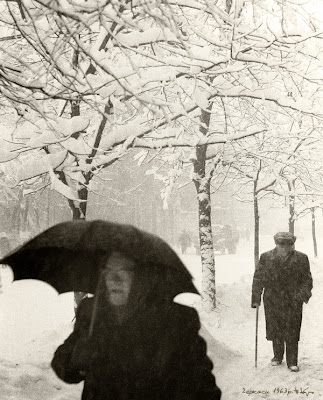
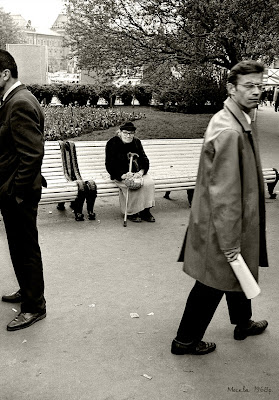
Starting off with my PHOTOGRAPHER OF THE WEEK, I really recommend checking out this website, everyone: photographyserved.com. I have found some excellent photographers, that would otherwise be unknown to me, if it hadn't been my sister who introduced this website to my incredibly eager eyes. A photographer I found for this week is Vladimir Kukorenchuk, a Ukrainian man who captures the essence of eastern Europe vividly. A collection I found of his work (on the website listed above), was centered around "old age" in Ukraine. You see your typical Babushka wearing Bubushka (I know that sounds redundant, but Babushka means both "grandmother" and "scarf" in Russian haha), intertwined with older folk men, and the grisley, cold feel of the lonleyness of old age. It looks like he only works in film, at least for this one series of photographs, but in both black and white and color.
Now, As for my 10 RULES FOR TAKING A PHOTOGRAPH:
1) I always go with rule of thirds, or at least, try to. I like the "classically trained" aspect of it.
2) I tend to shoot a little darker, meaning, I tend to have a smaller aperture or a faster shutter speed. I'm a fan of darker photographs, possibly because they're more mysterious, and more my own.
3)I like subject matter a whole lot. I am not a fan of most abstract photography. If I can shoot a building with a person in front of it, versus a building without a person, I will 99% of the time, go with a subject matter in my image.
4) I will always go for real life people versus posed people.
5) Big fan of wide angle, and capturing the whole landscape.
6) I don't photograph sculptures or art that others have made. I feel like it's almost some sort of plagerism.
7) Street photography and landscape photography > everything else.
8) Never macro. ever. Nobody cares about the detail of a combination lock. Really.
9) I now always change my white balance. ALWAYS. no excuses.
10) I'm patient when it comes to nature photography. I will wait for that fog to come across the meadow. I will wait for that deer to look me straight in lens. I will wait for the sky to change and unfold. I will wait.
Lastly, THE PHOTOGRAPH i AM AFRAID TO TAKE.
It's difficult so take this photograph, on account that I haven't the means to travel, really. I need travel to take a photograph. I get too eager to move on and see more, instead of really focus on one place for a long period of time. However, the photograph that I see myself wanting to take (I guess more in the future, however) more than anything else, has to do with poverty. I have never lived in poverty and of course, hope to never. Both my parents have lived in a poverty-ridden household or country. My mother is from El Salvador, where even still, civil war is not completely over, even though it'd been going on since the late 1970s. She has seen poverty, and the ill, and the dead. She has experienced poverty, when she didn't know when the next meal was coming from, or when an awful earthquake in the early 70s happened to destroy her entire home, leaving her and her family homeless for god knows how long. My father grew up in Rye, New York, which is technically a wealthy little town, 30 minutes above Manhattan. But he grew up poor. He grew up unpriviledged financially, and had to move out of his own house, and was living on his own, by the age of 16, just because his mother could no longer support him and herself. I want to see poverty. I cannot become sympathetic with my parents entirely, when I have not witnessed these things myself. The poverty I have witnessed has been only that of homeless people. But to be engulfed in a country of entire poverty or war-torn destruction is intriguing and heart-wrenching. I need to see these things and process them, so that I may become more hopeful and thankful for myself. I am so incredibly afraid to take a photograph of poverty, because I am afraid that I will shut down and be overly affected by the scenario. But it's something I want to take at the same time. It's difficult to explain. I don't want the aesthetic pleasures; I want the raw and the pure. I want to give a voice to the people who can't seem to get that, for some reason or another.
How to Take a Good Photo Using 10 Rules + That Photo I'm Afraid to Take
- Incorporate basic rules/photography tools: rule of thirds, framing, diagonals & lines, etc. - but especially the rule of thirds.
- a. If shooting with film, remember that colors become greys.
b. If shooting in digital/color, be aware of lighting and how it makes colors look that way - Only change the ISO if absolutely necessary, in most situations; otherwise, 800 & below is ideal.
- Photograph friends, not necessarily WITH friends, unless those friends are also photographers.
- Do not always rely on the light meter.
- Bracket, especially for digital.
- Have patience. Lots of patience.
- When shooting landscape/scenery, be especially especially ESPECIALLY aware of what's in your frame.
- Be aware of touchy, possibly dangerous or possibly risky subject matter/shooting locations.
- Note & experiment with the angles at which you are viewing and COULD view things; move around, crouch, get on your tummy, tower over things, climb...
The commercial moneymakers, the magazine covers, the makeup ads, the royal gatherings: portraits. I mean, sure, I know the basics, I know there's that weird angle that makes the subject's nose awkwardly huge, there are certain ways to light certain subjects, there are certain lighting situations for certain moods and reasons, reflectors are a necessity, poses are important... Yet I still don't feel quite as confident as I suppose I should (I was even sort of relieved when I turned down the Picture People, who called me back for a job interview). It's the idea of the glamorous Annie Leibovitz portrait, the must-be-perfect wedding portrait that intimidates me. But these reasons are partially why I'm here.
my 10 rules for a good photograph & the one i'm scared to take.
Friday, September 23, 2011
My week's photographer





Wednesday, September 21, 2011
David Hamilton
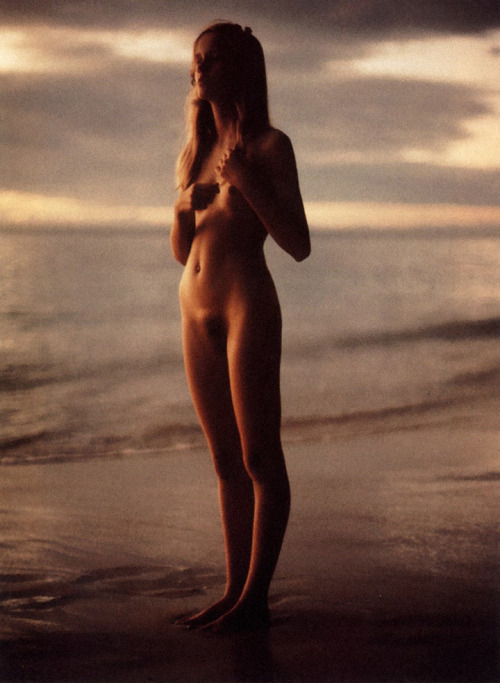
Tuesday, September 20, 2011
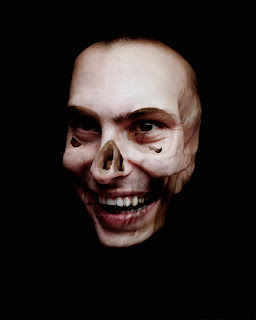
I first saw some of his work in ESPN the Magazine and decided to learn more about Christian Weber. This statement drew me into wanting to learn more about the artist and his work, “Christian Weber is a filmmaker and photographer who is consistently recognized for challenging the conventional interpretation of beauty”. I saw this image and several other pictures that revolve around the face of a skeleton and a human face. This image in particular made me feels that it literally spoke to what we deem as beautiful and the saying " Beauty is only skin deep" came to mind. If you get the chance check this out one of his videos.
Monday, September 19, 2011

cindy sherman

cindy sherman. what a lady. what a disgusting, grotesque, innovative, and narcissistic photographer---and yet, she surely knows how to serve herself and the public. she knows the concept of color and light relation. she knows how to contrast, she knows how to be provocative. she also plays with sets and self-made figures (from what seems to be clay or plastic), which i find very artful.
she's brilliant with lighting. i look for inspiration from her for this upcoming color/light project.
Kari Liimatainen
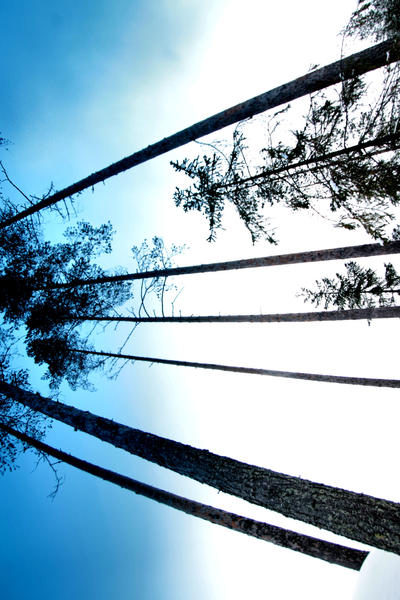 I began browsing around DeviantArt in search of photographs that don't appear too cliche or too amateur, and ones that aren't for anime cosplay things.
I began browsing around DeviantArt in search of photographs that don't appear too cliche or too amateur, and ones that aren't for anime cosplay things.So what I stumbled upon was this - just a "test" by Liimatainen. I don't know any background information on this, any details, or any information about the artist. I saw other tests much like this that were just as splendid in color and composition, but this is my favorite.
In relation to our light & color assignment, this photograph has a nice display of color - in the beautiful mysterious sky/mountain, in the fog or shadow or what ever that is, and even the slight tiny of color in the trees. The angle at which this was shot at is extreme and makes the trees appear to be reaching at the mountain, blending with the color change from the snow to the blue. The silhouettes of the trees against the white parts of the image are a nice contrast, something there to keep the eye company instead of leaving white space - I think the smooth blue at the top of the image makes up for empty space.
William Albert Allard
